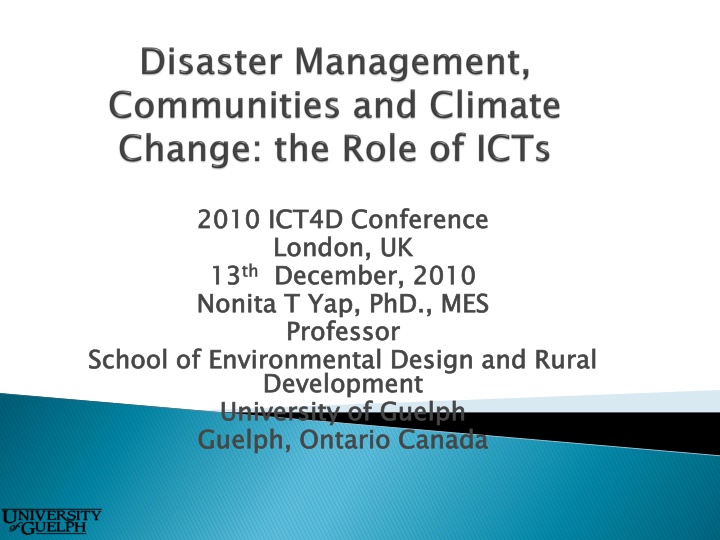
Disaster Management and ICT Capabilities for Effective Response
Explore the link between disaster management and ICT capabilities, emphasizing the importance of data acquisition, processing, and analysis under severe time pressure to enhance response efforts. Learn about the factors contributing to effective ICT use in disaster management, such as broadband internet penetration and improved decision support systems for better resource allocation and public engagement.
Download Presentation

Please find below an Image/Link to download the presentation.
The content on the website is provided AS IS for your information and personal use only. It may not be sold, licensed, or shared on other websites without obtaining consent from the author. If you encounter any issues during the download, it is possible that the publisher has removed the file from their server.
You are allowed to download the files provided on this website for personal or commercial use, subject to the condition that they are used lawfully. All files are the property of their respective owners.
The content on the website is provided AS IS for your information and personal use only. It may not be sold, licensed, or shared on other websites without obtaining consent from the author.
E N D
Presentation Transcript
2010 ICT4D Conference London, UK 13 Nonita T Yap, PhD., MES Professor School of Environmental Design and Rural Development University of Guelph Guelph, Ontario Canada 2010 ICT4D Conference London, UK 13th Nonita T Yap, PhD., MES Professor School of Environmental Design and Rural Development University of Guelph Guelph, Ontario Canada thDecember, 2010 December, 2010
1. Disaster and development link 2. Context for ICT use in developing country disasters 3. ICT capabilities necessary for improving DM/Factors contributing to effective ICT use in DM 4. Information and communication needs in DM in developing countries examples of ICT applications 5. Strategic recommendations 6. Areas for future research 2 2 2025-03-18 Prof. Nonita T Yap
No consensus what is a disaster what are the different disaster phases Agreement disaster management is best conceptualised as a cycle management phases form a continuum 2 types of natural disasters slow onset rapid onset 3 2025-03-18 Prof. Nonita T Yap
Data - needs to be acquired, processed and analysed under severe time pressure Data and information - from multiple sources with different standards -> interoperability Involvement of different agencies with slightly different mandates > coordination Disaster (rapid onset) situation fluid, dynamic Barriers to information access and response options isolation, culture, religious, legal, organisational, technological, infrastructure Data users are frequently without adequate training and working under difficult conditions 1. 2. 3. 4. 5. 6. 4 2025-03-18 Prof. Nonita T Yap
Factors contributing to effective (2007) Adequate penetration of broadband internet Factors contributing to effective ICT use in DM (2007) ICT capabilities needed for improving DM (US NRC 2007) ICT capabilities needed for improving DM (US NRC 2007) ICT use in DM More robust, interoperable, and priority-sensitive ICT Intra- and inter-agency coordination Improved situational awareness and a common operational picture Competence in data analysis, interpretation, integration, maintenance and repair of hardware Common technical and operating standards on access to ICT Improved decision support and resource tracking and allocation Greater organisational agility Interoperability of devices, equipment, networks, and systems Better public engagement Sustained advance preparedness Enhanced infrastructure survivability and continuity of social function 5 2025-03-18 Prof. Nonita T Yap
1. Effective delivery of understandable, actionable disaster alerts to the last mile 2. Dissemination of hazard information to as many as possible as quickly as possible 3. Collection, processing, integration of data from multiple sources 4. Management continuity when telecom infrastructure and links are compromised 5. Intra- and inter-agency coordination 6. Transparent and accountable resource allocation and use 6 2025-03-18 Prof. Nonita T Yap
Effective delivery of EW to the last mile Dissemination to as many as possible as quickly as possible Collection, processing & integration of data from multiple sources Management continuity when telecom infrastructure and links are compromised Intra- and inter-agency coordination Transparent and accountable resource allocation and use Radio, television, phone (fixed and mobile), CB Radio, television, phone (fixed and mobile), CB, Web 2.0 GIS cum remote sensing (EOS, UAV, GPS) Wireless Internet, satellite-based communication CIS+ remote sensing, GPS, Web 2.0, USHAHIDI, DUMBO, SAHANA, DAD 1. 1. 2. 2. 3. 3. 4. 4. 5. 5. 6. 6. Need ICT tools Prof. Nonita T Yap 7 2025-03-18
1. Continuity: anticipate the unexpected, prepare for the worst 2. Effectiveness: know the context 3. Sustainability: build local capacity 4. Synergies: learn from, share and work with others 5. Systems design: technology & management flexible, monitor, evaluate learn, adjust 6. Put people at the centre, not the technology: define the problem before the solution Continuity: anticipate the unexpected, prepare for the worst 2. Effectiveness: know the context 3. Sustainability: build local capacity 4. Synergies: learn from, share and work with others 5. Systems design: technology & management flexible, composable monitor, evaluate learn, adjust 6. Put people at the centre, not the technology: define the problem before the solution 1. composable, interoperable , interoperable STRATEGIC RECOMMENDATIONS STRATEGIC RECOMMENDATIONS 8 2025-03-18 Prof. Nonita T Yap
Technology development Reliable radio communication inside rubble, underground Data mining across diverse information sources Human Interrelationship between technology and organisational Interrelationship between technology and policy Systematic assessment of impacts of ICTs on quality and effectiveness of DM practices Technology development Reliable radio communication inside rubble, underground Data mining across diverse information sources Human technology interface Interrelationship between technology and organisational models Interrelationship between technology and policy Systematic assessment of impacts of ICTs on quality and effectiveness of DM practices technology interface models Areas for future research Areas for future research 9 2025-03-18 Prof. Nonita T Yap






















